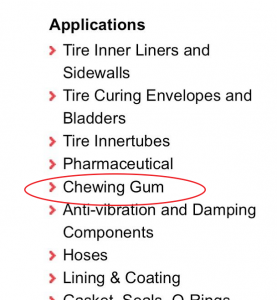Tire Parts in Your Chewing Gum

[/vc_column_text][/vc_column][vc_column width=”1/2″][vc_empty_space][vc_column_text]Butyl rubber (IIR), also called isobutylene-isoprene rubber, a synthetic rubber produced by copolymerizing isobutylene with small amounts of isoprene. Valued for its chemical inertness, impermeability to gases, and weatherability, butyl rubber is employed in the inner linings of automobile tires and in other specialty applications.
 [/vc_column_text][/vc_column][/vc_row][vc_row][vc_column][vc_empty_space height=”20px”][vc_column_text]Butyl rubber was first produced by American chemists William Sparks and Robert Thomas at the Standard Oil Company of New Jersey (now Exxon Corporation) in 1937.
[/vc_column_text][/vc_column][/vc_row][vc_row][vc_column][vc_empty_space height=”20px”][vc_column_text]Butyl rubber was first produced by American chemists William Sparks and Robert Thomas at the Standard Oil Company of New Jersey (now Exxon Corporation) in 1937.
It’s used for a lot of different applications, as seen in the box on the right: tire inner liners, hoses, lining and coating.
According to Exxon, its manufacturer, it poses little risk to humans with this caveat around “Consumer use of products containing BUTYL RUBBER”—”For the majority of the consumer, exposure is expected to be infrequent, of short duration and of no significant consequence.”
So I’m wondering if gum chewers know this, because that tends to be frequent, of duration and might have a consequence. Either way, it really is interesting to know that Exxon makes a material used in tires and inner tubes that is also found in our chewing gum.
Food for thought. #dumpthejunk
Sources:
http://www.britannica.com/science/butyl-rubber
https://www.exxonmobilchemical.com/Chem-English/Files/Resources/butyl-safety.pdf
Photo by {Charlotte.Morrall} 





